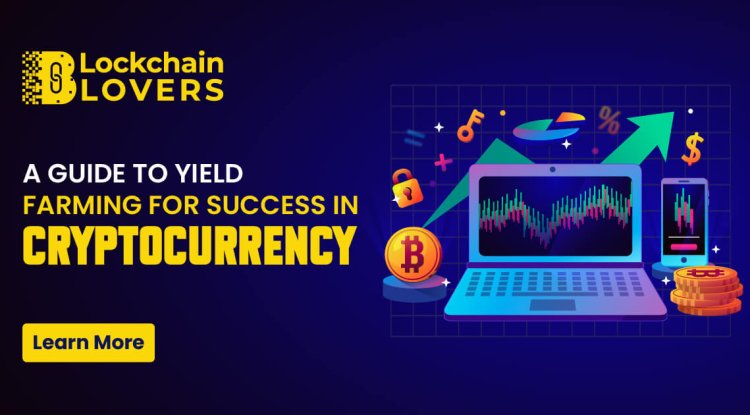A Guide to Yield Farming for Success in Cryptocurrency
Imagine a row of crops on a farm—arranged in such a way that they produce the maximum possible food. A farmer carefully plans and organizes these rows so that each plant grows properly and yields enough harvest. Crypto yield farming works in a very similar way.

Imagine a row of crops on a farm—arranged in such a way that they produce the maximum possible food. A farmer carefully plans and organizes these rows so that each plant grows properly and yields enough harvest. Crypto yield farming works in a very similar way. The main difference is that, as a farmer in this case, you are not trying to grow real crops. Instead, you aim to make the most out of your digital assets to earn returns in the form of interest, fees, or rewards. Your ultimate goal is to maximize the return you can get from your cryptocurrency holdings.
When we talk about crypto staking, you usually lock your tokens for a certain period and wait, without having much to do during that time. But yield farming is quite different. It is an active process where you constantly engage with your assets and manage them. If we compare it to agriculture, it is more like a type of farming where the farmer does not just sow seeds once and wait. Instead, the farmer keeps rotating crops and takes steps to ensure maximum production both in the short term and in the long term. However, where a real-world farmer has to wait the entire season from planting to harvesting, a yield farmer in crypto is in a much more flexible position. With just a few clicks, they can easily shift their digital assets from one platform to another to seize better earning opportunities.
What is Yield Farming?
Yield farming is essentially a process where investors or farmers move their cryptocurrency holdings to DeFi (Decentralized Finance) platforms in order to achieve the highest possible return. Here, farmers try to earn from multiple sources at once, such as interest, fees, and rewards. Since interest rates and reward rates on DeFi platforms often change over time, these farmers or investors are always looking for the best opportunities where their assets can produce the highest yield. That’s why they often move their digital assets from one protocol to another, depending on where they find the best returns at any given moment.
Yield farmers provide liquidity to DeFi platforms, which mainly helps make trading between buyers and sellers easier in the market. This is actually one of the most important aspects of yield farming. Farmers can take part in this process in several ways. For example:
They can deposit their crypto assets into liquidity pools, from which they can earn income at either fixed or variable rates depending on market conditions.
They can reinvest their earnings in a compounding manner, meaning they use their rewards to generate even more returns.
They can stake the platform-native tokens they earn for providing liquidity to gain extra rewards on top of their usual earnings.
They can swap the reward tokens for other tokens and reinvest those to create additional earning opportunities.
They can use leverage to increase their yield farming position, meaning they borrow funds to invest more and try to earn higher returns.
These yield farming strategies can sometimes become quite complex. This is because they often involve combining multiple protocols, different types of tokens, and various farming techniques. In many cases, a farmer participates in several protocols at once and creates a complex chain where they can earn layered or stacked rewards. It becomes a kind of planned asset management, where the farmer or investor distributes their tokens in such a way that income is generated at multiple levels.
How Does Yield Farming Work?
Yield farming mainly works through smart contracts, and you can do it manually or automatically depending on your preference. If you choose a yield farming platform that offers automation, you won’t need to constantly search for the DeFi protocols offering the highest yields at any given time. The platform’s algorithm will handle that task for you. But while this adds convenience, it also introduces some risks. When you leave decision-making in the hands of an algorithm, you give up a certain level of control, which can sometimes lead to unexpected risks.
If you want to understand how yield farming works and gain hands-on experience, you can follow these six simple steps to get started. But remember—just like any crypto investment, yield farming also carries risks. Especially when you invest in strategies you don’t fully understand, it can feel like playing with fire.
1. Create a Digital Wallet
The first step to starting yield farming is creating a reliable digital wallet. This is essential for participating in any decentralized finance (DeFi) activity. There are many types of wallets available, but you should choose one that integrates well with DeFi platforms and supports major stablecoins like Ethereum (ETH), Tether (USDT), or USD Coin (USDC). These coins are widely used in DeFi for providing liquidity and earning returns.
2. Buy Cryptocurrency
After setting up your wallet, the next step is to fund it with cryptocurrency. You can start with a mix of coins like Ethereum, USDT, or USDC. These can be purchased through a centralized exchange (such as Binance or Coinbase) or a decentralized exchange (like Uniswap). After buying, transfer your tokens to your digital wallet. Make sure the exchange you choose is compatible with your wallet.
If you’re unsure about which tokens to buy or how much to start with, consider beginning with small amounts. Try a few dollars’ worth of different coins to plant your first digital seeds.
3. Select a Yield Farming Platform
Next, choose a trusted yield farming platform. If you prefer not to manage everything manually, you can pick an aggregator platform that automatically finds the highest-yielding protocols. Make sure to research well and choose a secure and transparent platform. Examples include Yearn Finance or Harvest Finance, which move your investments across protocols for maximum yield.
4. Deposit Tokens into a Pool or Strategy
Whether you go with an automatic platform or manual farming, you’ll need to deposit your tokens. On automated platforms, you can simply choose a strategy from a list, and the platform will distribute your tokens across different protocols.
If you prefer to manage everything yourself, you’ll need to identify the DeFi platforms offering the highest yields and deposit your tokens into their liquidity pools.
5. Monitor Performance
If you farm manually, it’s important to regularly check the market conditions. You’ll need to understand which platforms are giving the best returns and move your assets accordingly.
If you choose an automated method, your job is easier. Just check your dashboard to see how your assets are performing, what yield you’re getting, and how much in rewards you’ve accumulated.
6. Reinvest or Withdraw Your Rewards
As your earnings grow, you’ll need to decide whether to reinvest your rewards or withdraw them. Many platforms offer auto-compounding options to help increase your profits further.
Risks and Benefits of Yield Farming
The chance to maximize returns in crypto through yield farming can seem very appealing to many. After all, the potential for higher profits in a short time attracts a lot of investors. But it’s important to remember—yield farming comes with significant risks. In fact, sometimes it can be even riskier than high-risk strategies in traditional finance, such as carry trades, junk bond investments, or other speculative approaches. Whether in DeFi (decentralized finance) or TradFi (traditional finance), one thing is clear—where there’s greater reward, there’s usually greater risk. Risk and reward almost always go hand in hand.
What Are the Risks of Yield Farming?
Although yield farming relies on smart contracts, and many of these contracts are audited, flaws or vulnerabilities may still exist. Hackers or bad actors can take advantage of these gaps to steal or damage your assets.
Another major risk is token price volatility. Cryptocurrency prices are very volatile, causing their value to decrease and increase rapidly. If many participants suddenly enter or leave a liquidity pool at the same time, it can cause liquidity issues. This could reduce your profits or even put your initial investment at risk.
It’s common in yield farming to use multiple DeFi protocols at once. This increases both the risk and complexity. If any one of those platforms has a problem, your entire farming effort could suffer.
Unlike bonds or credit-rated financial products, DeFi platforms don’t usually have formal credit ratings. That means it can be hard for investors to judge the trustworthiness of the team behind a platform or protocol.
What Are the Benefits of Yield Farming?
If you use smart strategies or automated tools, yield farming can offer relatively high returns or passive income opportunities.
DeFi platforms often reward participants with different types of tokens. This can help diversify your crypto portfolio and strengthen your overall investment position.
Yield farming also gives you the chance to discover new DeFi projects, tokens, or technologies. In a way, it becomes a learning opportunity where you can explore and experiment.
One of the biggest advantages of yield farming is flexibility. You can change your strategy or exit your farming position anytime you want without much hassle.
The Bottom Line
Only you can decide if productive farming is right for you. The important thing is to do the right research and make sure you really understand what you are getting into. Are you willing to put in the effort to learn? Are you mentally prepared to take on the extra risks? If your answer is yes, then productive farming may be a place worth exploring and gaining experience.
Start small. Manage your digital assets responsibly. Invest only as much as you can so that losing it won't have any impact on your life. Grow your experience gradually and move forward with care. Best of luck on your yield farming journey!
The names of cryptocurrencies or platforms mentioned in this article are for educational purposes only. They should not be seen as investment advice or endorsements.
What's Your Reaction?





















